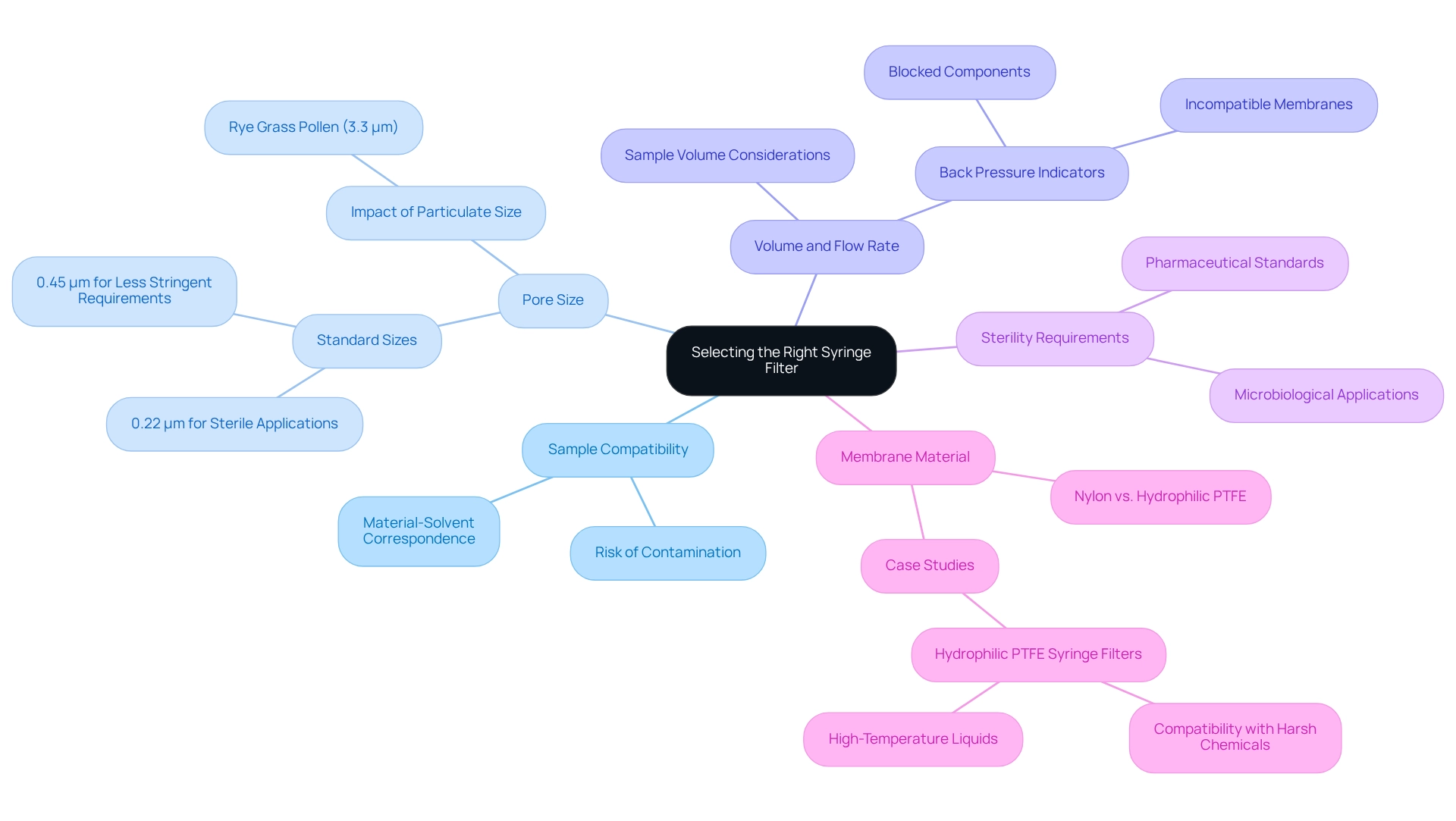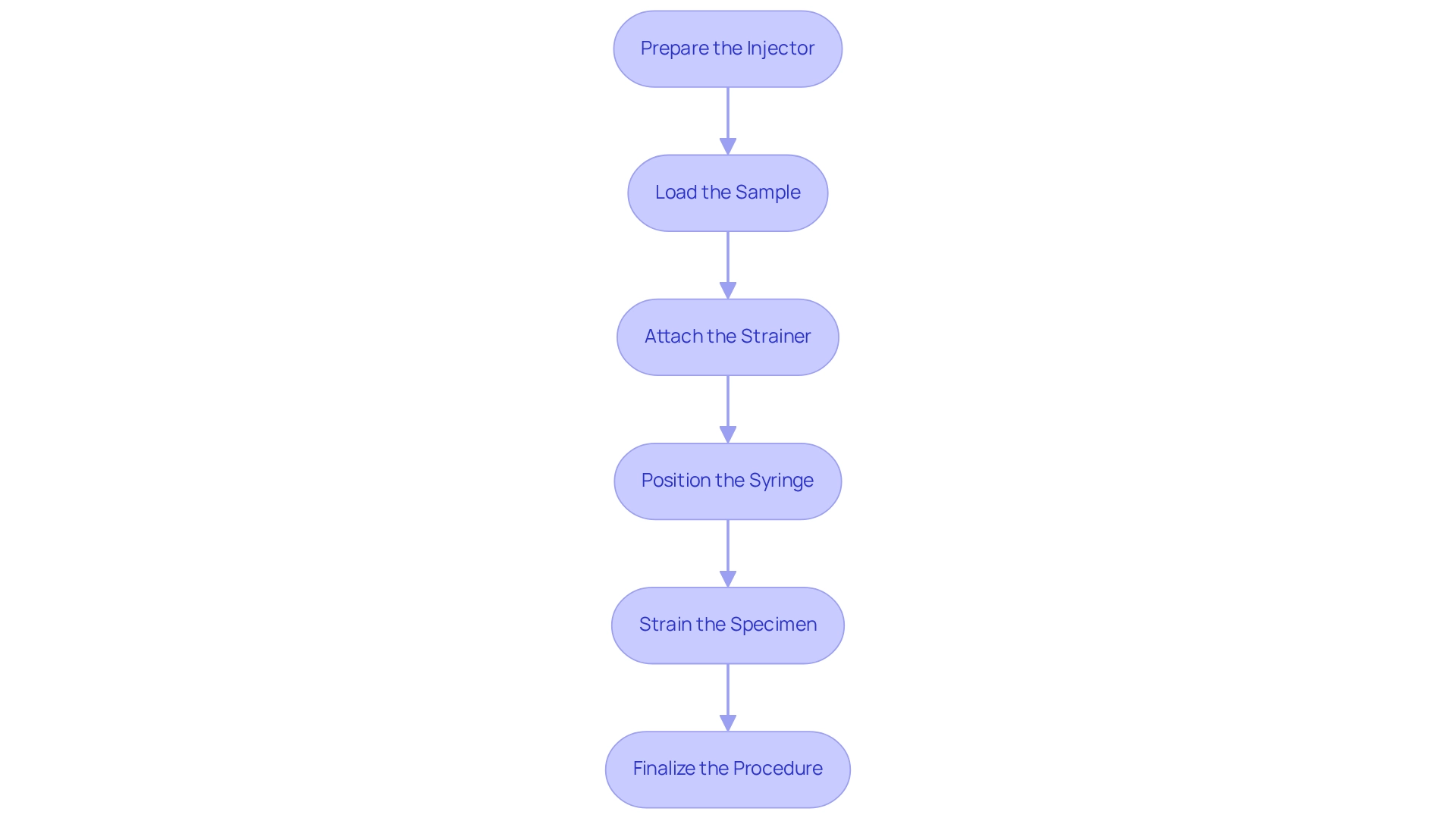Overview
This article presents comprehensive step-by-step instructions on the effective use of syringe filters, underscoring the critical nature of proper technique to ensure sample purity and accurate analytical results. It highlights key considerations such as:
- Sample compatibility
- Pore size
It offers solutions to common issues like:
- Clogging
- Leakage
These insights serve to guide lab managers in the appropriate selection and utilization of syringe filters, reinforcing the significance of high-quality scientific instruments in laboratory environments.
Introduction
In the realm of laboratory analysis, the significance of syringe filters is paramount. These essential tools are crucial for ensuring the purity of liquid samples, which directly impacts the accuracy of results across various applications, from high-performance liquid chromatography to microbiological testing.
With a diverse array of options available, including different membrane materials and pore sizes, selecting the appropriate syringe filter is a nuanced process that requires careful consideration of specific laboratory needs.
As the market for these filters continues to expand, driven by advancements in personalized medicine and biosimilars, understanding their functionality and applications becomes increasingly vital for laboratory managers seeking to enhance analytical reliability and efficiency.
This article explores the essential aspects of syringe filters, offering insights into their purpose, selection criteria, usage instructions, and troubleshooting common issues, thereby equipping professionals with the knowledge necessary to optimize their filtration processes.
Understand Syringe Filters: Purpose and Types
Syringe strainers are indispensable tools in laboratory settings, particularly when considering how to use syringe filter to remove particulates from liquid specimens before analysis. Their design is pivotal in ensuring sample purity, which is essential for achieving accurate results across various applications, including high-performance liquid chromatography (HPLC) and microbiological testing. Different types of filtration devices exist, categorized by membrane material—such as nylon, PTFE, and PVDF—and pore size, with options like 0.22 µm for sterile filtration and 0.45 µm for general use. Each type serves distinct purposes, including sterilization, clarification, or pre-filtration, making it crucial for lab managers to assess their specific needs prior to selection.
Recent trends show a notable rise in the utilization of microfilters for applications in environmental monitoring and food and beverage analysis, in addition to laboratory investigations. The injection device market, valued at USD 16.77 billion in 2023, is projected to grow to USD 27.70 billion by 2031, reflecting a compound annual growth rate (CAGR) of 6.72%. This growth is primarily driven by advancements in personalized medicine and biosimilar production, which are expected to account for over 33% of the additional demand for filtration devices globally. Such developments necessitate careful selection, and understanding how to use syringe filter is essential in choosing the right type, as it can significantly impact the accuracy and reliability of analytical results across diverse applications. Different varieties uniquely enhance the efficiency and reliability of . For example, choosing the correct membrane material and pore size can optimize filtration performance, ensuring that your results are both precise and reproducible.
Select the Right Syringe Filter: Key Considerations
When considering how to use syringe filter, several key factors must be taken into account to ensure optimal performance and compatibility.
- Sample Compatibility: Confirming that the material corresponds with the solvents and samples being utilized is essential. Incompatibility can lead to chemical reactions or contamination, compromising the integrity of your results.
- Pore Size: The selection of pore size is crucial for efficient separation. For sterile applications, a 0.22 µm filter is standard, while a 0.45 µm filter is generally suitable for less stringent requirements. Understanding the size of particulates, such as the approximate 3.3 micrometers of rye grass pollen, is essential, as this size can impact the filtration process and the quality of the results.
- Volume and Flow Rate: Evaluate the sample volume and the desired flow rate. Larger volumes may require devices designed for higher capacity to maintain efficiency and prevent back pressure, which can indicate a blocked component or an incompatible membrane.
- Sterility Requirements: Consider whether your application necessitates sterile membranes, especially in microbiological or pharmaceutical settings, to avoid contamination and guarantee adherence to industry standards.
- Membrane Material: Different membrane materials, such as nylon and hydrophilic PTFE, exhibit varying chemical compatibilities and flow characteristics. For example, hydrophilic PTFE devices are especially efficient for aqueous substances blended with strong chemicals, as shown in case studies where they have been effectively employed in various laboratory applications.
By thoughtfully evaluating these elements and emphasizing how to use syringe filter correctly, laboratory managers can choose . This reduces problems such as sample leakage or breakage and enhances the reliability of their analytical processes.

Use a Syringe Filter: Step-by-Step Instructions
To utilize a syringe filter effectively, follow these essential steps:
- Prepare the Injector: Begin by opening the filter packaging, ensuring that the injector is clean and dry to prevent any contamination.
- Load the Sample: Draw the liquid sample into the injection device. If necessary, draw a small amount of air into the device to minimize any liquid residue.
- Attach the Strainer: Securely connect the needle assembly to the strainer by twisting it into position, ensuring a tight seal to prevent leaks.
- Position the Syringe: Hold the syringe vertically, with the screen pointing downwards over the collection container.
- Strain the Specimen: Gradually press down the plunger to move the specimen through the strainer. Apply gentle, steady pressure to avoid rupturing the membrane, which is crucial for maintaining the integrity of the specimen and preventing clogs in HPLC columns. As noted, "Syringe membranes play a crucial role in HPLC preparation by removing particulate matter and preserving integrity, thereby preventing blockages of HPLC columns which could lead to erroneous results and cause harm."
- Finalize the Procedure: Once the sample has been purified, carefully remove the filtration device and discard it according to your laboratory's waste disposal protocols.
Understanding how to use syringe filter and selecting the appropriate filtration devices, while considering factors such as membrane material—cellulose acetate, PVDF, nylon, PTFE, and PES—and , is vital for optimal performance and reliability in laboratory analyses. As the market for injection device membranes expands, particularly in the Asia-Pacific region, staying informed about advancements in membrane materials and designs will enhance laboratory methods and ensure high-quality outcomes.

Troubleshoot Common Syringe Filter Issues
Understanding how to use syringe filter can help address common issues encountered and provide solutions that warrant attention to ensure optimal laboratory performance.
Clogging is a prevalent problem, often indicated by a notable reduction in the filtering process. To mitigate this issue, you should learn how to use syringe filter with larger pore sizes or pre-filter samples to eliminate larger particulates. Research indicates that employing advanced purification techniques, such as , can further enhance efficiency and reduce clogging rates. A recent study titled "Methodological Advances in Water Quality Assessment" highlights the effectiveness of such techniques in minimizing clogging effects during filtration processes.
Leakage poses another challenge. If liquid escapes around the strainer, it is essential to ensure a firm connection to the injector. Examine both the strainer and syringe for any damage that could undermine the seal. Proper installation is crucial to prevent leakage, and knowing how to use syringe filter can help avoid sample contamination.
Bursting housing is a critical concern; excessive pressure can cause the housing to rupture. To avoid this, apply pressure slowly and steadily. It is crucial to monitor pressure levels during filtration to uphold the integrity of the system and avert damage, particularly when understanding how to use syringe filter.
Test loss may occur if the strainer is not appropriate for the test type or if the maximum volume capacity is exceeded. Always confirm that the chosen criterion aligns with the characteristics of the specimen and complies with suggested volume restrictions. Notably, the concentrations of filterable forms of Al, Fe, and REEs can vary significantly depending on the season, underscoring the importance of selecting appropriate filters based on sample characteristics.
By addressing these common problems with effective solutions, laboratory managers can enhance the reliability of their separation methods, ultimately improving their analyses by understanding how to use syringe filter. As Dr. Susanne Huhmann aptly noted, "Slow filtration isn’t just frustrating — it can indicate a problem," emphasizing the need for vigilance in filtration practices.
Conclusion
Syringe filters are indispensable in laboratory analysis, playing a vital role in ensuring the purity and integrity of liquid samples across diverse applications. It is crucial to understand their purpose, types, and the specific requirements of your laboratory to select the appropriate filter. Key considerations, including:
- Sample compatibility
- Pore size
- Volume
- Flow rate
- Sterility requirements
- Membrane material
must be meticulously evaluated to optimize filtration performance.
Proper usage of syringe filters, guided by a systematic approach, can significantly enhance the reliability of analytical processes. Addressing common issues such as clogging, leakage, and sample loss through effective troubleshooting strategies further underscores the importance of diligent filtration practices.
As the demand for syringe filters continues to rise, propelled by advancements in personalized medicine and biosimilars, it is vital to stay informed about the latest developments in filter technology. By prioritizing the selection and usage of suitable syringe filters, laboratory managers can ensure accurate results and improve overall analytical efficiency. This commitment to quality and precision not only impacts immediate laboratory outcomes but also contributes to the broader field of scientific research and innovation.




